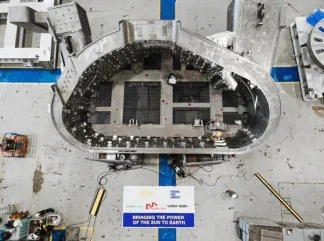
Fusion for Energy (F4E), the ITER Organisation’s European domestic agency, has completed manufacture of the first of five vacuum vessel (plasma chamber) sectors for the International Thermonuclear Experimental Reactor’s (ITER). The component will be delivered from Italy to the construction site of the tokamak fusion device in Cadarache, France. The sector is expected to depart from Italy before the end of September and will travel by sea to Fos-sur-Mer, the industrial port of Marseille, France. It will then be loaded on to a trailer to be driven to ITER site.
ITER’s plasma chamber that will house the fusion reactions acts as a first safety containment barrier. It will be formed from nine wedge-shaped steel sectors that measure more than 14 metres in height and weigh 440 tonnes. With an interior volume of 1400 cubic metres, the chamber, once assembled, will have an outer diameter of 19.4 metres, a height of 11.4 metres, and weigh approximately 5200 tonnes. Following installation of in-vessel components such as the blanket and the divertor, the vacuum vessel will weigh 8500 tonnes.
Fabrication of the vacuum vessel sectors is shared between Europe (five sectors) and Korea (four sectors). Sector 6, at the centre of the assembly, and associated thermal shielding has already been manufactured and delivered by the Korean Domestic Agency. at all the manufacturing sites, large teams of technicians, metrology experts, engineers and quality assurance officers continuously inspected production. Each sector includes some 150 km of welding beads.
More than 20,000 hours of machining and at least 100,000 hours of welding were required to produce Europe’s first sector. Two of its segments (1&4) were manufactured by Westinghouse in Monfalcone, while the other two (2&3) were produced by Walter Tosto in Chieti.
The first sector (5) being supplied by Europe has now been assembled at the Westinghouse/Mangiarotti facility in Monfalcone, Italy. The sector’s fabrication involved ten years of work directly involving more than 150 professionals, and at least 15 companies across Europe with their respective workforces.
“Europe’s first sector results from the partnership between F4E, the consortium of Ansaldo Nucleare, Westinghouse, Walter Tosto and ITER Organization,” said F4E Director Marc Lachaise. “Our commitment to deliver, the teamwork and innovative thinking have been the driving forces of this impressive achievement.” Europe’s remaining four sectors are being manufactured and will be delivered in the next two years.
Joan Caixas, F4E Project Manager for the Vacuum Vessel said the production of sector 5 has been a fascinating learning curve for Europe and its industrial suppliers. “We managed to overcome the technical challenges in production, and those of schedule, successfully. We followed the manufacturing process with rigour and made progress with great care and confidence. This results from the meaningful collaboration between F4E, the AMW consortium, their sub-suppliers and ITER Organisation, who took part to so many meetings, contributed to the revision of strategies, and travelled to so many of our factories. Personally, I feel very proud to be part of a team of colleagues that delivered Europe’s first vacuum vessel sector.”
The goal of ITER is to operate at 500 MW (for at least 400 seconds continuously) with 50 MW of plasma heating power input. No electricity will be generated. An additional 300 MWe of electricity input may be required for operation.
ITER is a first-of-a-kind global collaboration. As the host, Europe contributes almost half of the costs of its construction (45.6%), while the other six members of this joint international venture (China, India, Japan, South Korea, Russia and the US), contribute equally for the remaining expenses (9.1% each). However, in practice, the members deliver little monetary contribution to the project, instead providing ‘in-kind’ contributions of components, systems or buildings.
The goal of ITER is to operate at 500 MW (for at least 400 seconds continuously) with 50 MW of plasma heating power input. Some 35 nations are collaborating in the construction of ITER, which began in 2010, many of them through their Domestic Agencies. The European Union is contributing almost half of the cost of its construction, while the other six members (China, India, Japan, South Korea, Russia and the USA) are contributing equally to the rest.
Construction began in 2010 and the original 2018 first plasma target date was put back to 2025 by the ITER council in 2016. However, in June this year, a revised project plan was announced which aims for “a scientifically and technically robust initial phase of operations, including deuterium-deuterium fusion operation in 2035 followed by full magnetic energy and plasma current operation”.
Researched and written by Judith Perera






